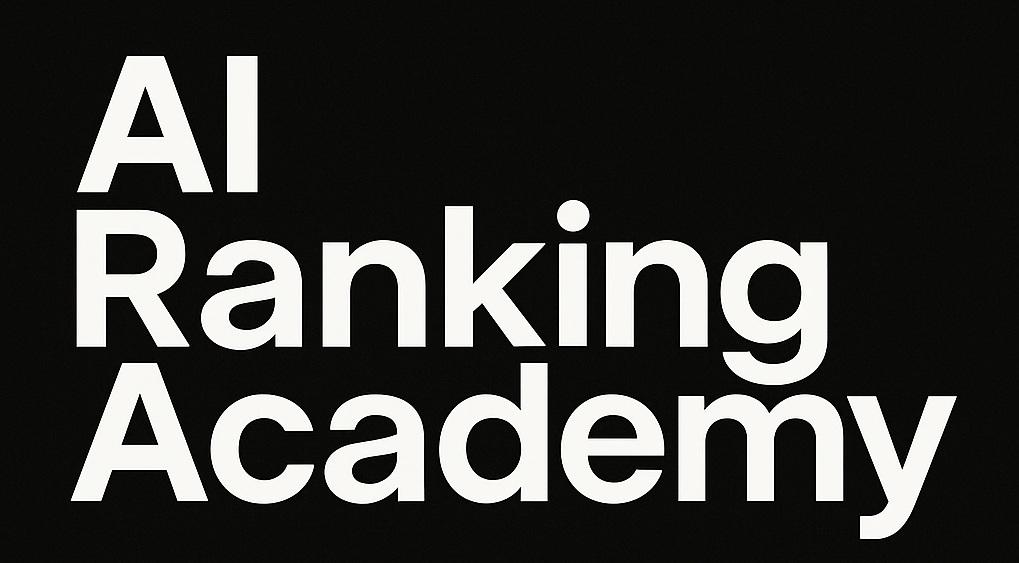In a Hurry? Here’s the Short Version
The Game Has Changed.
ChatGPT, Perplexity, and Google’s AI Overviews now control discovery. If AI doesn’t cite you, you don’t exist.
What Matters Now
Forget keyword rankings. Track mentions and citations, they’re the new currency of trust and authority.
This Guide Covers:
✅ How to audit your current AI visibility
✅ How to structure content AI can parse and cite
✅ The authority signals AIs actually trust
✅ The new KPIs replacing rankings
✅ A step-by-step framework for AI visibility growth
Bottom Line:
SEO isn’t dead — it’s evolved.
You’re either in the AI’s answer… or invisible.
Search has shifted and most brands haven’t noticed
SEO rankings don’t matter if AI ignores you.
While marketers still obsess over Google positions and backlinks, the real shift has already happened. AI-powered search engines like ChatGPT, Claude, Perplexity, and Google’s AI Overviews (SGE) are rewriting how people discover brands.
ChatGPT now attracts over 5.8 billion monthly visits, and Google’s AI summaries appear in nearly 9 out of 10 search queries. Yet most businesses haven’t started optimising for this reality.
That creates a rare window (a first-mover advantage) for those who act now.
What AI Visibility Actually Means
AI Visibility measures how often your brand or content appears inside AI-generated answers across platforms like ChatGPT, Perplexity, Claude, Gemini, and Microsoft Copilot.
In traditional SEO, your goal is page one.
In AI search, the goal is citation or mention, you’re either part of the answer, or invisible.
There’s no position two, No page two. No impressions.
Only presence or absence.
AI engines synthesise information from trusted sources and cite the few domains they consider credible. Your mission is to become one of them.
The Two Channel Search Reality
You’re no longer competing in one search ecosystem.
You’re in two:
- Traditional search engines (Google, Bing): Lists of links.
- Answer engines (ChatGPT, SGE, Perplexity): Synthesised, conversational responses.
The difference isn’t cosmetic, it’s structural.
The average Google query is 3–5 words.
The average ChatGPT query is 24.
That shift means users are expressing full intent, context, goals, and constraint, in a single prompt. Your content has to be structured to match that intent.
Why Traditional SEO Falls Short
Old-school SEO plays: keyword matching, link chasing, generic blog publishing. Just don’t cut it anymore.
AI engines pull from multiple sources, but typically cite just 2–7 domains per response. Compare that to Google’s ten blue links per page.
If your content looks like everyone else’s, it will never make the cut.
Instead of ranking by keyword density or backlinks alone, AI engines rank by clarity, structure, and authority signals.
“Most AI models don’t ‘rank’, they select. That’s a binary system. Either you’re trustworthy enough to be cited, or you’re filtered out.”
How AI Is Changing User Behaviour
People are no longer browsing. They’re conversing.
When users ask AI engines questions, they expect immediate, synthesised answers.
For simple queries like opening hours, quick definitions, or basic facts, users rarely leave the AI interface.
But for complex, purchase-driven or high-trust queries, they do click through, and they’re far more qualified when they do.
AI is acting as a filter, sending you fewer visitors but better ones.
That means your traffic may drop while conversions rise.
New Metrics That Actually Matter
In AI search, rankings are meaningless (well they play a part, but).
The new success metrics are mentions and citations.
Mentions = Awareness
When AI mentions your brand name without linking, it signals entity recognition. It means the model “knows” who you are.
Citations = Authority
When the AI engine links directly to your content, it’s recognising your expertise as a trusted source.
Track These Instead of Rankings
- Frequency of brand mentions across AI platforms
- Citation count and link context
- Crawl activity from AI agents (e.g. GPTBot, PerplexityBot)
- Share of voice versus competitors
- Inclusion rate in AI responses to buyer questions
- Referral traffic from AI interfaces
Manual tracking is hard, so invest in emerging tools like Ahrefs Brand Radar, Profound, or Nozzle AI.
How AI Platforms Source Information
AI engines combine two major data streams:
Training data: static knowledge captured during model development.
Live web crawling: real-time retrieval from current content.
Established brands have an advantage if they were part of early training datasets. But new, well-structured content can still break through by meeting AI criteria: clarity, freshness, and external validation.
AI engines trust third-party mentions more than self-promotion.
That’s why digital PR, citations, and authoritative backlinks are now more powerful than keyword optimisation alone.
“AI systems treat off-domain validation like human reputation. The more other sources mention and contextualise you, the more you’re trusted.”
How to Test Your Current AI Visibility
Before you optimise, benchmark where you stand.
Step-by-Step Audit
Open ChatGPT, Claude, Perplexity, and Google AI Overviews.
Ask questions your customers would:
- What’s the best SEO framework for AI search?
- How do I get cited in ChatGPT answers?
- How can I recover traffic lost to SGE?
Note which brands appear.
Document whether you’re mentioned or cited.
Run the same prompts multiple times, as AI answers can vary.
This gives you your AI visibility baseline. From there, you can track improvements as you implement optimisation.
Content Formats AI Engines Prefer
Not all content types are treated equally. Through extensive testing, certain formats consistently perform best for AI citations:
- Best of or Top XLists – Curated comparison content.
- Comparison Articles: X vs Y pieces with objective pros and cons.
- How-To Guides & Tutorials, Step-by-step instructional content.
- FAQs & Definitions, Short, direct answers to popular questions.
- Product & Service Pages. Clear, factual information beats fluff.
- Original Research & Data Studies, AI loves unique insights it can’t find elsewhere.
The pattern is simple: the more decision-focused the format, the more likely it is to be cited.
Optimising Content Structure for AI Comprehension
AI reads differently than humans.
It prefers clarity, structure, and hierarchy.
Formatting Best Practices
- Keep paragraphs short (2–3 sentences max).
- Use H2/H3 headings to map topics clearly.
- Include bullet points and numbered lists for easy parsing.
- Use question-based subheadings (What is…, How to…) to match natural queries.
Style Guidelines
- Lead with the answer, then elaborate.
- Write conversationally, match how people ask questions aloud.
- Define jargon inline to help AI interpret niche terms.
- Include synonyms and related concepts to expand coverage.
Technical Implementation
Add Schema Markup:
- FAQPage for question-answer sections
- HowTo for tutorials
- Article for long-form guides
Structured data makes your content easier for AI engines to classify and retrieve.
Building Authority Signals (E-E-A-T)
AI platforms prioritise demonstrable expertise.
To show Experience, Expertise, Authoritativeness, and Trustworthiness (E-E-A-T):
- Include author bios with credentials.
- Publish first-party research and proprietary data.
- Cite reputable external sources.
- Add case studies and testimonials.
- Keep pages updated, AI engines reward recency.
“Treat every page like a mini knowledge node. Connect it through internal links that reinforce your topical authority.”
Scaling Content for AI Discovery
AI visibility isn’t built on volume alone, but consistency and frequency amplify recognition.
Publishing five blogs per quarter won’t cut it.
You need content velocity — regular, structured publishing that signals ongoing expertise.
The Repurposing Strategy
Turn every major piece into a multi-format ecosystem:
- Blog post → social carousel → short video → Reddit thread → email snippet.
- Each touchpoint feeds AI discovery through cross-platform signals.
Maintain a publishing rhythm, not just random output. AI engines learn from repetition and recency.
Platform-Specific Optimisation
AI engines draw heavily from certain platforms. Here’s how to leverage them:
- YouTube: Videos are increasingly cited in AI answers. Optimise titles, transcripts, and descriptions for clarity.
- Reddit: Genuine discussions and expert replies carry major weight in AI datasets.
- Review Sites & Industry Publications: Third-party validation boosts trust.
- Podcasts & Interviews: Rich source material for conversational AI training.
Participate where authority is earned, not bought.
Building Third-Party Validation
Self-promotion doesn’t impress AI.
External mentions do.
Ways to Earn Citations
- Guest articles and thought leadership pieces on reputable sites.
- Digital PR campaigns that generate brand mentions in relevant media.
- Collaborations and round-ups featuring your insights.
- Industry awards, reports, or community recognition.
Every external mention reinforces your entity footprint, making it easier for AI to connect your brand with specific topics.
“If you’re not earning citations, build relationships, not backlinks.”
Monitoring, Measurement, and Attribution
Traditional analytics can’t fully measure AI-driven discovery.
Someone who first saw your name in ChatGPT and then Googled you will appear as direct traffic in GA4.
This creates dark social AI influence, visibility that isn’t tracked but directly impacts trust and conversions.
What to Track
- AI Mentions – how often your brand is named in answer engines.
- Citation Context – when and why you’re referenced.
- Share of Voice (SOV) – compare to competitors.
- Conversion Source Trends – watch for branded search uplift.
- AI Bot Traffic – monitor GPTBot, PerplexityBot, and others in logs.
Use data to inform your next move, not to chase vanity metrics.
Your AI Visibility Action Plan
Let’s turn this into action.
This Week
- Test your brand in ChatGPT, Claude, and Perplexity for your top buyer questions.
- Record where (and if) you appear.
- Audit your homepage and key product pages for AI readability.
This Month
- Add FAQ schema to your most-visited content.
- Refresh top 10 pages with clear, conversational answers.
- Publish one comparison or “best of” article in your niche.
- Reclaim unlinked mentions with a simple outreach campaign.
This Quarter
- Set up automated AI mention tracking.
- Build a content repurposing workflow.
- Launch digital PR targeting authoritative domains.
- Publish one piece of original research or data study.
- Add AI visibility metrics to your reporting dashboard.
“AI visibility isn’t a one-off project — it’s a new layer of search strategy. Track it like SEO. Improve it like CRO.”
Final Word: The Future of Visibility
Search has changed forever.
Traditional SEO still matters, but it’s no longer enough.
AI Visibility is the new front line of discovery, where credibility, structure, and validation decide who gets seen.
Brands that adapt now will dominate the AI-powered decade ahead.
Those who don’t will disappear quietly into the model’s blind spot.

